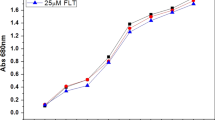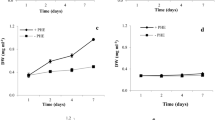Abstract
Polycyclic aromatic hydrocarbons (PAHs) have high risks for human and living organisms due to their mutagenic and carcinogenic properties. Here, the effect of different concentrations of fluorene as a persistent toxic PAH on growth parameters and antioxidant systems in the green microalga Chlorella vulgaris was investigated. Intriguingly, cell number as well as dry and fresh weight of the alga were raised at 2 ppm fluorene compared to the control sample. However, with the increasing levels of fluorene from 10 to 50 mg L−1, the growth parameters gradually decreased. Accordingly, cells of C. vulgaris were found to enhance the activity of ROS scavenging enzymes after 7 days of exposure to fluorene in a concentration-dependent manner. Exposure to 25 and 50 mg L−1 fluorene was led to a significant decrease at chlorophyll content, whereas the concentration of carotenoids was not changed. Total phenol and flavonoid contents were markedly raised in 50 mg L−1 of fluorene compared to the control. Although flow cytometry assessment showed no substantial reduction in the viability at 50 mg L−1 fluorene-treated samples for 24 h, chlorophyll fluorescence was noticeably reduced. The results of SEM analysis revealed that the 50 mg L−1 fluorene treatment clearly damaged the algal cells after 24 h. The ability of the alga for biodegradation of fluorene was assessed by GC-MS. Consequently, a number of produced intermediate compounds were identified. These findings displayed that C. vulgaris had not only notable resistance against fluorene but also noteworthy potential for its degradation.








Similar content being viewed by others
References
Asghari S, Movafeghi A, Lisar SYS, Barar J, Omidi Y (2018) Effects of phenanthrene on growth parameters and antioxidant systems in the green microalga Chlorella vulgaris. Biointerface Res Appl Chem 8:3405–3411
Bautista I, Boscaiu M, Lidón A, Llinares JV, Lull C, Donat MP, Mayoral O, Vicente O (2016) Environmentally induced changes in antioxidant phenolic compounds levels in wild plants. Acta Physiol Plant 38:9
Bradford MM (1976) A rapid and sensitive method for the quantitation of microgram quantities of protein utilizing the principle of protein-dye binding. Anal Biochem 72:248–254
Casellas M, Grifoll M, Bayona JM, Solanas AM (1997) New metabolites in the degradation of fluorene by Arthrobacter sp. strain F101. Appl Environ Microbiol 63:819–826
Çelekli A, Gültekin E, Bozkurt H (2016) Morphological and biochemical responses of Spirogyra setiformis exposed to cadmium. Clean-Soil Air Water 44:256–262
Chang C-C, Yang M-H, Wen H-M, Chern J-C (2002) Estimation of total flavonoid content in propolis by two complementary colorimetric methods. J Food Drug Anal 10:178–182
Cheema SA, Khan MI, Shen C, Tang X, Farooq M, Chen L, Zhang C, Chen Y (2010) Degradation of phenanthrene and pyrene in spiked soils by single and combined plants cultivation. J Hazard Mater 177:384–389
Cheng J, Qiu H, Chang Z, Jiang Z, Yin W (2016) The effect of cadmium on the growth and antioxidant response for freshwater algae Chlorella vulgaris. Springerplus 5:1290
Comotto M, Casazza AA, Aliakbarian B, Caratto V, Ferretti M, Perego P (2014) Influence of TiO2 nanoparticles on growth and phenolic compounds production in photosynthetic microorganisms. Sci World J 2014:1–9
El-Sheekh MM, Hamouda RA, Nizam AA (2013) Biodegradation of crude oil by Scenedesmus obliquus and Chlorella vulgaris growing under heterotrophic conditions. Int Biodeterior Biodegradation 82:67–72
Fazelian N, Movafeghi A, Yousefzadi M, Rahimzadeh M (2019) Cytotoxic impacts of CuO nanoparticles on the marine microalga Nannochloropsis oculata. Environ Sci Pollut Res 26:17499–17511
Haritash A, Kaushik C (2009) Biodegradation aspects of polycyclic aromatic hydrocarbons (PAHs): a review. J Hazard Mater 169:1–15
Hong Y-W, Yuan D-X, Lin Q-M, Yang T-L (2008) Accumulation and biodegradation of phenanthrene and fluoranthene by the algae enriched from a mangrove aquatic ecosystem. Mar Pollut Bull 56:1400–1405
Jaleel CA, Riadh K, Gopi R, Manivannan P, Ines J, Al-Juburi HJ, Chang-Xing Z, Hong-Bo S, Panneerselvam R (2009) Antioxidant defense responses: physiological plasticity in higher plants under abiotic constraints. Acta Physiol Plant 31:427–436
Kalhor AX, Nassab ADM, Abedi E, Bahrami A, Movafeghi A (2016) Biodiesel production in crude oil contaminated environment using Chlorella vulgaris. Bioresour Technol 222:190–194
Kalhor AX, Movafeghi A, Mohammadi-Nassab AD, Abedi E, Bahrami A (2017) Potential of the green alga Chlorella vulgaris for biodegradation of crude oil hydrocarbons. Mar Pollut Bull 123:286–290
Karydis M (1981) The toxicity of crude oil for the marine alga Skeletonema costatum (Greville) Cleve in relation to nutrient limitation. Hydrobiologia 85:137–143
Kim K-H, Jahan SA, Kabir E, Brown RJ (2013) A review of airborne polycyclic aromatic hydrocarbons (PAHs) and their human health effects. Environ Int 60:71–80
Kirso U, Irha N (1998) Role of algae in fate of carcinogenic polycyclic aromatic hydrocarbons in the aquatic environment. Ecotoxicol Environ Saf 41:83–89
Lei A, Hu Z, Wong Y, Tam NF (2006) Antioxidant responses of microalgal species to pyrene. J Appl Phycol 18:67–78
Lei A-P, Hu Z-L, Wong Y-S, Tam NF-Y (2007) Removal of fluoranthene and pyrene by different microalgal species. Bioresour Technol 98:273–280
Lichtenthaler HK (1987) Chlorophylls and carotenoids: pigments of photosynthetic biomembranes. Methods Enzymol 148:350–382
Liu H, Weisman D, Ye Y-B, Cui B, Huang Y-H, Colón-Carmona A, Wang Z-H (2009) An oxidative stress response to polycyclic aromatic hydrocarbon exposure is rapid and complex in Arabidopsis thaliana. Plant Sci 176:375–382
Maehly A, Chance B (1955) Assay of catalases and peroxidases, in methods in enzymology. Methods Enzymol 2:764–775
Mahjouri S, Movafeghi A, Divband B, Kosari-Nasab M (2018a) Toxicity impacts of chemically and biologically synthesized CuO nanoparticles on cell suspension cultures of Nicotiana tabacum. Plant Cell Tissue Organ Cult 135:223–234
Mahjouri S, Movafeghi A, Divband B, Kosari-Nasab M, Kazemi EM (2018b) Assessing the toxicity of silver nanoparticles in cell suspension culture of Nicotiana tabacum. Biointerface Res Appl Chem 8:3252–3258
Mallick N (2004) Copper-induced oxidative stress in the chlorophycean microalga Chlorella vulgaris: response of the antioxidant system. J Plant Physiol 161:591–597
Meda A, Lamien CE, Romito M, Millogo J, Nacoulma OG (2005) Determination of the total phenolic, flavonoid and proline contents in Burkina Fasan honey, as well as their radical scavenging activity. Food Chem 91:571–577
Munoz R, Guieysse B, Mattiasson B (2003) Phenanthrene biodegradation by an algal-bacterial consortium in two-phase partitioning bioreactors. Appl Microbiol Biotechnol 61:261–267
Nakano Y, Asada K (1981) Hydrogen peroxide is scavenged by ascorbate-specific peroxidase in spinach chloroplasts. Plant Cell Physiol 22:867–880
Nazari F, Movafeghi A, Jafarirad S, Kosari-Nasab M, Divband B (2018) Synthesis of reduced graphene oxide-silver nanocomposites and assessing their toxicity on the green microalga Chlorella vulgaris. Bionanoscience 8:997–1007
Patel JG, Kumar JN, Kumar RN, Khan SR (2016) Biodegradation capability and enzymatic variation of potentially hazardous polycyclic aromatic hydrocarbons—anthracene and pyrene by Anabaena fertilissima. Polycycl Aromat Comp 36:72–87
Qian H, Li J, Pan X, Sun L, Lu T, Ran H, Fu Z (2011) Combined effect of copper and cadmium on heavy metal ion bioaccumulation and antioxidant enzymes induction in Chlorella vulgaris. Bull Environ Contam Toxicol 87:512–516
Qian H, Li J, Pan X, Sun Z, Ye C, Jin G, Fu Z (2012) Effects of streptomycin on growth of algae Chlorella vulgaris and Microcystis aeruginosa. Environ Toxicol 27:229–237
Rai U, Singh N, Upadhyay A, Verma S (2013) Chromate tolerance and accumulation in Chlorella vulgaris L.: role of antioxidant enzymes and biochemical changes in detoxification of metals. Bioresour Technol 136:604–609
Rawat I, Kumar RR, Mutanda T, Bux F (2011) Dual role of microalgae: phycoremediation of domestic wastewater and biomass production for sustainable biofuels production. Appl Energy 88:3411–3424
Sáenz ME, Di Marzio WD, Alberdi JL (2012) Assessment of Cyfluthrin commercial formulation on growth, photosynthesis and catalase activity of green algae. Pestic Biochem Physiol 104:50–57
Safi C, Zebib B, Merah O, Pontalier P-Y, Vaca-Garcia C (2014) Morphology, composition, production, processing and applications of Chlorella vulgaris: a review. Renew Sust Energ Rev 35:265–278
Salehi-Lisar SY, Deljoo S (2015) The physiological effect of fluorene on Triticum aestivum, Medicago sativa, and Helianthus annus. Cogent Food Agric 1:1020189
Semple KT, Cain RB, Schmidt S (1999) Biodegradation of aromatic compounds by microalgae. FEMS Microbiol Lett 170:291–300
Shen C, Miao J, Li Y, Pan L (2016) Effect of benzo [a] pyrene on detoxification and the activity of antioxidant enzymes of marine microalgae. J Ocean U China 15:303–310
Soto C, Hellebust JA, Hutchinson TC (1975) Effect of naphthalene and aqueous crude oil extracts on the green flagellate Chlamydomonas angulosa. II. Photosynthesis and the uptake and release of naphthalene. Can J Bot 53:118–126
Stanier RY, Kunisawa R, Mandel M, Cohen-Bazire G (1971) Purification and properties of unicellular blue-green algae (order Chroococcales). Bacteriol Rev 35:171
Subashchandrabose SR, Logeshwaran P, Venkateswarlu K, Naidu R, Megharaj M (2017) Pyrene degradation by Chlorella sp. MM3 in liquid medium and soil slurry: possible role of dihydrolipoamide acetyltransferase in pyrene biodegradation. Algal Res 23:223–232
Suman T, Rajasree SR, Kirubagaran R (2015) Evaluation of zinc oxide nanoparticles toxicity on marine algae Chlorella vulgaris through flow cytometric, cytotoxicity and oxidative stress analysis. Ecotoxicol Environ Saf 113:23–30
Takáčová A, Smolinská M, Ryba J, Mackuľak T, Jokrllová J, Hronec P, Čík G (2014) Biodegradation of benzo[a]pyrene through the use of algae. Cent Eur J Chem 12:1133–1143
Tarrahi R, Khataee A, Movafeghi A, Rezanejad F, Gohari G (2017) Toxicological implications of selenium nanoparticles with different coatings along with Se4+ on Lemna minor. Chemosphere 181:655–665
Vafaei F, Movafeghi A, Khataee A, Zarei M, Lisar SS (2013) Potential of Hydrocotyle vulgaris for phytoremediation of a textile dye: inducing antioxidant response in roots and leaves. Ecotoxicol Environ Saf 93:128–134
Wang HY, Zeng XB, Guo SY, Li ZT (2008) Effects of magnetic field on the antioxidant defense system of recirculation-cultured Chlorella vulgaris. Bioelectromagnetics 29:39–46
Warshawsky D, Cody T, Radike M, Reilman R, Schumann B, LaDow K, Schneider J (1995) Biotransformation of benzo [a] pyrene and other polycyclic aromatic hydrocarbons and heterocyclic analogs by several green algae and other algal species under gold and white light. Chem Biol Interact 97:131–148
Wei H, Song S, Tian H, Liu T (2014) Effects of phenanthrene on seed germination and some physiological activities of wheat seedling. C R Biol 337:95–100
Winterbourn CC, McGrath BM, Carrell RW (1976) Reactions involving superoxide and normal and unstable haemoglobins. Biochem J 155:493–502
Acknowledgments
We thank the University of Tabriz and Research Center for Pharmaceutical Nanotechnology at the Tabriz University of Medical Sciences for all supports provided.
Author information
Authors and Affiliations
Corresponding author
Additional information
Publisher’s note
Springer Nature remains neutral with regard to jurisdictional claims in published maps and institutional affiliations.
Rights and permissions
About this article
Cite this article
Asghari, S., Rajabi, F., Tarrahi, R. et al. Potential of the green microalga Chlorella vulgaris to fight against fluorene contamination: evaluation of antioxidant systems and identification of intermediate biodegradation compounds. J Appl Phycol 32, 411–419 (2020). https://doi.org/10.1007/s10811-019-01921-7
Received:
Revised:
Accepted:
Published:
Issue Date:
DOI: https://doi.org/10.1007/s10811-019-01921-7




